OSAKA
EVENT EVENT EVENT

Report on the "Kaorufu Kabuki Special Performance" commemorating the Osaka-Kansai Expo, where you can enjoy a new Butoh dance performance!
The "Kaorukaze Kabuki Special Performance" is a special Kabuki performance planned to commemorate the Osaka-Kansai Expo as part of the "Come to Osaka! Campaign," which aims to promote the attractiveness of Osaka both domestically and internationally and to encourage more people to visit Osaka.
Popular Kabuki actors from the East and West, including campaign ambassador Ainosuke Kataoka, will perform to convey the charm of Kabuki from Osaka to the world through a stage full of tradition and splendor.
The show will be held at the Osaka Shochikuza Theater from May 11 (Sun.) to May 25 (Sun.).
On May 11, with the scent of fresh green in the air and the venue filled with excitement, the curtain rose on the first day of the powerful performance, and we are pleased to report on all three parts.

first part
(1) Konjaku Kabuki Zoshi
(2) Pulse of the strange book, Yumemado Saiyuki (The Journey to the West by Dream Window)
The first part, "Konjaku Kabuki Zoshi" is a dynamic new dance performance that expresses the essence of the traditional Japanese performing art "Kabuki.
The curtain will open with a speech by Seitora Ichikawa, followed by a performance by Japanese dancers of the "Kabuki Dance," which was started by the Akuni troupe of Izumo, the birthplace of the Kabuki theater.
The delicate movements with the fan and the rich expressions of the performers can be seen throughout the performance, and not only can the beauty of the dance be fully appreciated, but there are also scenes where the performers come out to the audience seats, giving the audience the exciting feeling that they themselves are part of the stage.
The following "Kamigata Kabuki" will feature a scene from "Kurobunsho Yoshidaya" by Izaemon (Nakamura Senjaku) and Yugiri (Nakamura Ichitaro).
The funny dialogue, which is unique to Kamigata kabuki, allows the audience to enjoy the loveliness and humor of the performance.
When the stage was transformed, the world view changed to that of "Edo Kabuki. Nakamura T.Karino, Kataoka Ainosuke, and Ichikawa Chuguruma play the roles of Tobito, who is transformed into a lion, and the dynamic hair swing performed at the end of the act is a truly impressive performance that captivates the audience.
As the performance drew to a close, the applause of the entire audience grew louder and louder, and the audience and the stage became one in an uplifting atmosphere.
This is a spectacular and powerful dance performance of the history of Kabuki and representative Kabuki plays.
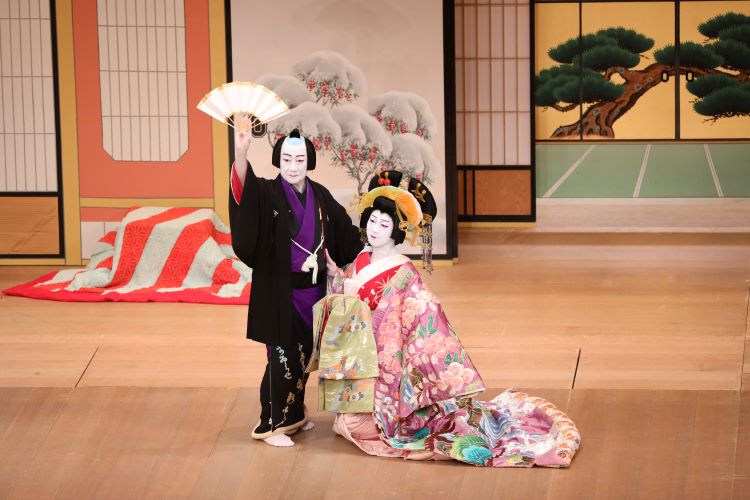
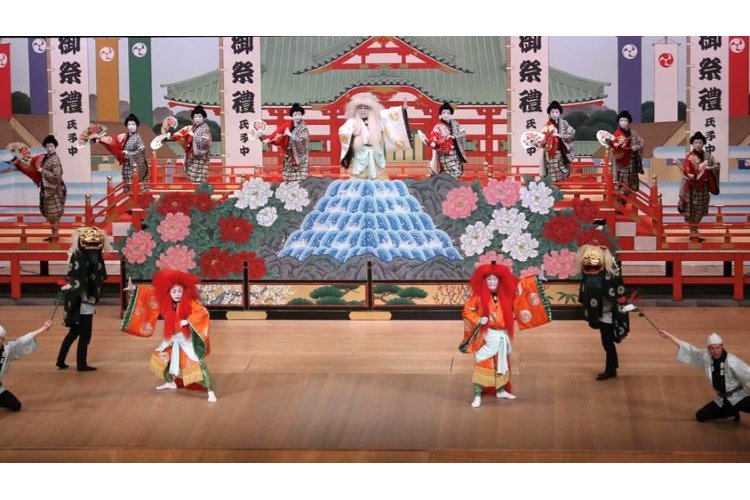
The following piece, "Pulse Kisho Ibun Yumemado Saiyuki" is a new Kabuki piece that takes the world of "Saiyuki", widely known in Japan, and replaces it with Azuchi-Momoyama period Japan.
The story begins with a daring setup in which Son Goku (Nakamura Hashinosuke) appears in Osaka as the Taikoo.
Son Goku, now lord of Osaka Castle, is manipulated by the Great Tengu (Ichikawa Shozaburo) and Princess Chacha, actually a nine-tailed fox (Ichikawa Shoya), who plan to turn this world into a demon world.
Inoha-kai (Nakamura Fukunosuke) and Shagojo (Nakamura Utanosuke) cooperate with the ancient Japanese native deities to bring back Son Goku and fight against him.
The unique tools of "Journey to the West," such as a hoop, a nyoi bar, and a muscular cloud, will play an active role in many places. While making full use of the charm of the original story, the audience will be thrilled by the special performance's unique structure and splendid actors, including a unique Kabuki performance and an appearance by Vezumaru (Nakamura Kamekuru), who is associated with the Osaka/Kansai Expo.
The story unfolds with a sense of speed, and the dynamic movement of the performers on stage, such as their high leaps, and the comfortable tempo of the dialogue between the characters, as well as their calls to the audience, keep the audience entertained to the very end.
It was truly an energetic performance that could only be created by "Pulse Kisho Ibun Yumemado Saiyuki" that crossed the tradition and newness that have continued with Myakumyak.
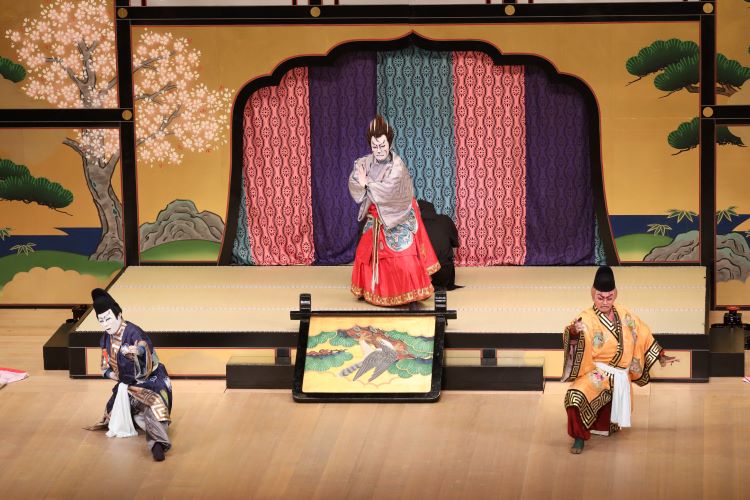
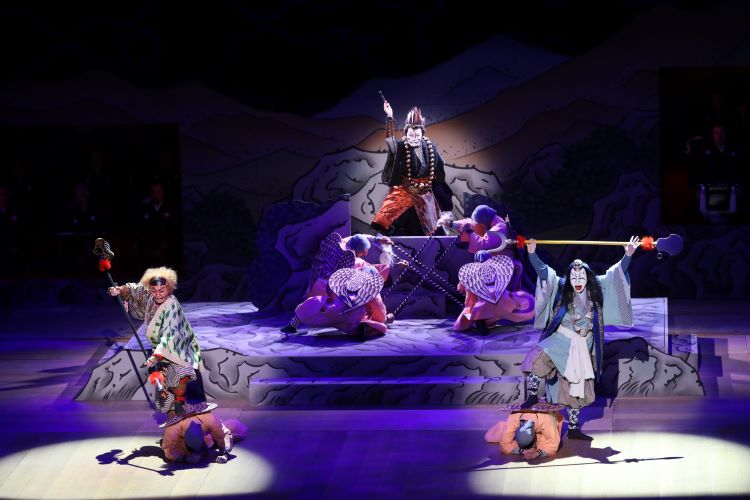

Glossary
Konjaku Kabuki-zoshi
Izumo no Okuni Ichiza
Izumo no Akuni" and his troupe performed "Kabuki Odori" in Kyoto during the Azuchi-Momoyama period.
Kabuki Odori (Kabuki Dance)
This dance is said to have been started by "Izumo no Akuni," and is the origin of the traditional Japanese performing art "Kabuki.
Kamigata kabuki
Kabuki developed in the Kansai region centering on Osaka and Kyoto. It is characterized by its humanistic content.
Edo Kabuki
Kabuki developed in Edo (present-day Tokyo). It is characterized by flamboyant stand-up routines and dynamic, powerful performances.
Tobigashira
It is the symbol of Edo Kabuki, the chic and inelegant fire extinguisher of the Edo period.
hair swing
The movement of the long hair waving widely. It is a dynamic and powerful show that captivates the audience.
end of act
The end of a play or performance, the climactic scene. The term refers to the conclusion of a story or a great circle.
Toyotomi Hideyoshi
This is a title for a person who has retired from the position of kanpaku (the highest-ranking official position assisting the emperor).
Ubusunagami
An ancient Japanese god that protects the land and region where he was born. It is a guardian deity that watches over the people and places that inhabit the land.
a hoop that is not tightened
A metal ring worn on the head of the Monkey King in Journey to the West. It is a tool used by the Sanzang Priest to tighten it by chanting sutras and subdue the Monkey King.
second division
Senya Ichiya Monogatari Arajin no Maki (One Thousand and One Nights: The Tale of One Thousand and One Nights, Arajin no Maki)
The second part, "One Thousand and One Nights, Aragami-no-Kan," is based on a collection of discourses from the Sasanian Persian period of the third to fifth centuries.
It proceeds in the form of the Persian king's wife telling the king a story each night, culminating in a tense situation on the thousandth night when her brother, accused of treason, will be released if the king is not bored.
The queen talks about "Aladdin and the Magic Lamp," which is particularly popular in Japan.
In this performance, this story will be presented as a new Kabuki play, boldly reconstructed in a Chinese setting.
From the fateful love story of Arajin (Toranosuke Nakamura) and Princess Marika (Ichitaro Nakamura), the demons of the Western Lights (T.Nakamura Ganjiro), (Enya Ichikawa) and the Spirit of the Ring (Lozaburo Ichikawa) appear and their wry dialogue will make the audience laugh.
There is also a production in which followers run around the auditorium in pursuit of Anrahito and Princess Marika, giving the audience an immersive experience as if they themselves were a part of "One Thousand and One Nights".
In addition, the dynamic scene changes of the stage set and the standing circle by a large number of people not only change the world view dramatically from scene to scene, but also incorporate many points that should not be missed, such as the use of smoke and fire.
Among the must-see scenes is the appearance of Makiribu (Ichikawa Chuguruma), a sorcerer who deceives Anrahito's uncle.
The audience was captivated by the unpredictable and unpredictable nature of the show, just like a real sorcerer.
The final part of the spectacular tale featured Anrahito and Princess Marika riding on a magic carpet through the night amidst sparkling confetti, to which the audience gave a resounding applause.
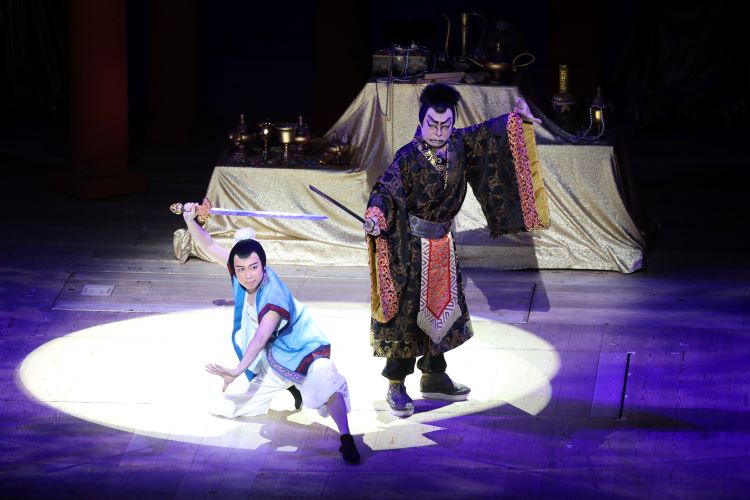
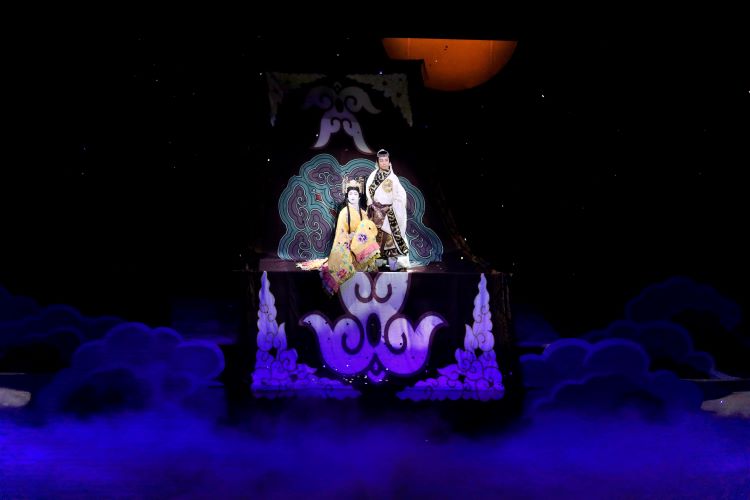
Glossary
A Thousand and One Nights.
Western Lamp
It means "lamp" or "lantern" in Japanese.
Flower Path
A unique stage set-up for Kabuki. It is an important staging space where actors appear and leave the stage in a passage-like area that runs through the audience seats and connects to the stage, and where the actors appear from their spurs.
soft-shelled turtle (Trionychidae)
A seri (elevator) in the middle of a hanamichi. It is used for a performance that suddenly appears and disappears.
Facial lighting
A type of stage lighting that illuminates the actors. It is a light that shines from the front so that the audience can see the actor's facial expressions clearly.
Part III.
Wakinoborumizu Koitaki Carp Catching (Wakinoborumizu Koitaki Carp Catching)
The third part, "Yongsosui Koi Taki" (also known as "Koi Catching"), has been popular and well-known since it was first performed in the Taisho era (1912-1926).
The story begins with the extermination of the giant centipede, and the major highlight of the play is the rapid change of roles, with Kataoka Ainosuke playing eleven different roles one after another, including Tawara Hidesato, who accomplishes this, the carp prince (Kin Koi), the villain Yogo Saemon, Nuno Setahei, and a woman (Tsurike Okupata Ren).
Ainosuke's skillful acting, somersaulting, and stage tricks are like magic tricks, sometimes so masterful that even the audience cannot detect them, and the audience applauds and cheers loudly.
In the second act, intrigue and human drama surrounding the treasured sword "Ryujinmaru" are also depicted, creating a dramatic storyline.
In the climax of "Lake Biwa Carp Extermination," Ainosuke somersaults into a large water tank that mimics a lake and performs a powerful tachimawari using real water.
The entire venue was so excited by the production that a large amount of water spray reached the center of the auditorium, and the audience was given tarps, far exceeding what they could have imagined.
Also not to be missed is the appearance of a motif of Myakmyak, the official character of the Osaka-Kansai Expo, which adds a sense of familiarity and humor to the story.
The "Carp Catcher," a fusion of tradition and innovation, captivated the audience with its overwhelming power and variety of attractions, and filled them with the excitement that only a spring Kabuki performance with the scent of fresh greenery can bring.
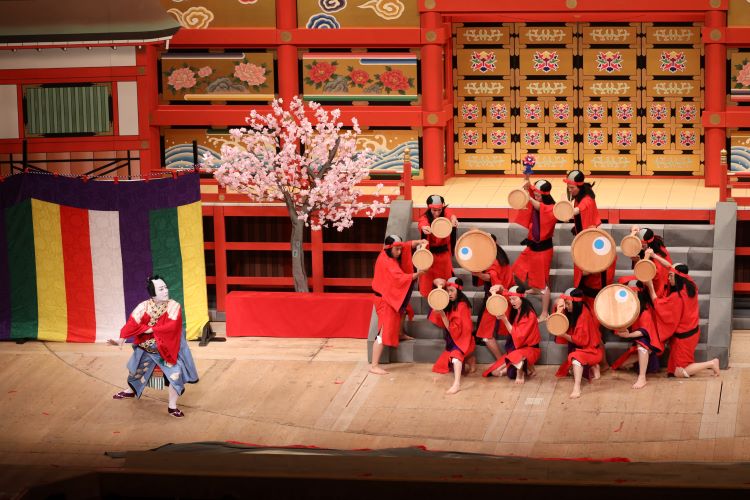


This time, through four plays, "Konjaku Kabuki Zoshi", "Kisho Ibun Yumemado Saiyuki", "One Thousand and One Nights Tan", and "Yusoshozui Koi Taki: Carp Catching", the audience was able to experience the power of Kabuki, its potential as diverse entertainment, and the enthusiasm of the "Kaorufu Kabuki Special Performance", which commemorated Expo 2005 Osaka/Kansai. The performance was filled with the enthusiasm unique to the "Kaorufu Kabuki Special Performance" commemorating the Osaka-Kansai Expo.
As symbolized by the official Expo character Myakmyak, Kabuki is another traditional Japanese culture that has been handed down from generation to generation.
It is hoped that this performance will help more people, both those who have not yet seen Kabuki and those visiting from overseas, to understand the appeal and depth of Kabuki.

